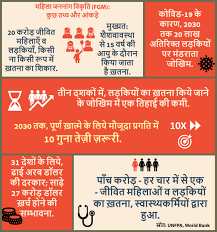
Female Genital Mutilation (FGM)
Female Genital Mutilation (FGM)
GS-2: Women Related Issues (Social Justice)
(UPSC/State PSC)
Important for preliminary exam:
Female Genital Mutilation (FGM), World Health Organization (WHO), United Nations Agencies, Sustainable Development Goals (SDGs), Ministry of Women and Child Development, UNICEF and United Nations Population Fund.
Important for Main Exam:
About Female Genital Mutilation (FGM), Global scenario related to Female Genital Mutilation (FGM), Status of FGM in India, Challenges in FGM eradication, Universal efforts to control Female Genital Mutilation (FGM), Way forward, Conclusion.
February 17, 2024
Why in news:
According to a recent statement issued by United Nations agencies, approximately 4.4 million girls worldwide are at risk of female genital mutilation in 2024.
About Female Genital Mutilation (FGM):
- It is a harmful practice based on social and gender norms in which the external female genitalia are partially or completely removed for non-medical reasons.
- The purpose of this misogyny is to control female sexuality and maintain purity, chastity and fidelity.
- FGM is most commonly performed on girls between infancy and the age of 15.
Impact of this practice on women:
- This affects the human rights, health and dignity of women.
- Women have to suffer serious physical and psychological consequences of this.
Global scenario related to Female Genital Mutilation (FGM):
- According to the World Health Organization (WHO), currently 30 countries in Africa, the Middle East and Asia are affected by FGM, where more than 200 million girls and women have been subjected to FGM.
- FGM is also practiced among immigrant communities in some countries in Latin America, Europe, North America, Australia and New Zealand.
Status of FGM in India:
- According to some unofficial reports, the FGM practice is mainly prevalent among the Bohra community in the states of Maharashtra, Kerala, Rajasthan, Gujarat and Madhya Pradesh.
- Lack of law: Currently, no law exists in the country to impose a ban on the practice of FGM.
- In 2017, in response to a petition in the Supreme Court, the Ministry of Women and Child Development had said that “there is currently no official data or study that supports the existence of FGM in India.
Challenges in FGM eradication:
- Stereotypical cultural and social norms: FGM is often deeply rooted in cultural and social norms, with communities treating it as a tradition passed down for generations.
- Changing these deeply entrenched beliefs and practices can be challenging.
- Lack of awareness and education in affected communities: Many individuals in communities where FGM is practiced may not fully understand the harmful consequences of the practice.
- Lack of awareness and education about the physical and psychological health risks associated with FGM can perpetuate its continuation.
- Lack of adequate data collection and reporting: Limited data collection and reporting on FGM prevalence hinders efforts to understand the scope of the issue and effectively target interventions.
Universal efforts to control Female Genital Mutilation (FGM):
Zero Tolerance International Day for FGM(ZTFGM):
- The theme of ZTFGM 2024 is: “Her Voice, Her Future”.
- The day is celebrated every year on 6 February since 2003 to raise awareness and take action to end the practice of female genital mutilation.
- The day was initiated by the Inter-African Committee (IAC) and later adopted by the United Nations General Assembly.
- The day provides an opportunity for governments, civil society, media, health professionals, religious leaders, survivors and activists to unite and reaffirm their commitment to end FGM by 2030 as part of the Sustainable Development Goals (SDGs).
Joint effort of UNICEF and United Nations Population Fund (UNFPA):
- UNICEF and the United Nations Population Fund (UNFPA) jointly lead the world’s largest programme to end FGM.
- Launched in 2008, the programme partners with communities to raise awareness of the harms caused by FGM and to shift social norms towards collective abandonment.
United Nations Sustainable Development Goals:
- The goal of achieving UN Development Goal 5 is to completely eliminate FGM by 2030.
- SDG 5.3 target includes eliminating all harmful practices, such as child, early and forced marriage and female genital mutilation.
Way forward:
- Existing laws banning FGM must be effectively enforced to punish those who facilitate the practice.
- Transparency and accountability must be ensured in the actions of FGM law enforcement agencies.
- Extensive awareness campaigns should be launched to educate communities about the harmful effects of FGM on physical, psychological and sexual health.
- All efforts to combat FGM must be based on human rights principles, so that women's confidence in these rights is maintained.
Conclusion:
Female genital mutilation remains a global challenge that requires a multidisciplinary and culturally sensitive approach. Governments, NGOs and international bodies should work for the protection of women's rights so that women can live their lives with the rights to freedom, equality and dignity in the future.
Source-The Hindu
-------------------------------------
Mains Question
Critically analyze universal efforts in addressing the challenges in eradicating Female Genital Mutilation (FGM).